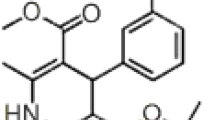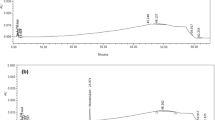Abstract
A gradient high performance liquid chromatographic method was developed to determine degradation products of adinazolam mesylate in a sustained release tablet formulation. Sample preparations were chromatographed on a YMC-Basic column using a formate buffer/acetonitrile gradient with absorbance detection at 254 nm. Adinazolam mesylate was found to degrade at high relative humidity and temperature to form a major product, the 6-aminoquinoline analog, plus numerous other compounds. Five of these compounds were identified and their structures indicate that the solid-state degradation of adinazolam, in the presence of sufficient moisture, involves not only a hydrolytic mechanism, but also an oxidative mechanism. Potential process impurities were resolved from the drug and degradation products. Recovery was near 100% over the 0.5 to 10% range for the major degradate (6-aminoquinoline) and over the 0.5 to 1% range for the other analytes. The method was applied to tablet samples stressed at high relative humidity and temperature. The relative standard deviation of the assay for the 6-aminoquinoline was less than 2% and less than 13% for the minor components. Calculated mass balances (sum of adinazolam plus degradation products in the degraded tablet divided by the same sum in the undegraded tablet) were less than 100% and were dependent on the extent of degradation in the tablet. The average mass balance result obtained for samples that were an average of 9.5% degraded was 95.0 ± 1.5%. It is possible that the decrease in mass balance with increase in percent degradation may be explained by the formation of many components at trace levels due to degradation by various permutations of hydrolytic and oxidative reaction pathways.
Similar content being viewed by others
REFERENCES
M. Japp, K. Garthwaite, A. V. Geeson, and M. D. Osselton. Collection of analytical data for benzodiazepines and benzophenones. J. Chromatogr. 439:317–339 (1988).
L. A. Berrueta, B. Gallo, and F. Vicente. Biopharmacological data and high-performance liquid chromatographic analysis of 1,4-benzodiazepines in biological fluids: a review. J. Pharmaceutical & Biomedical Analysis 10:109–136 (1992).
D. L. Theis and P. B. Bowman. Development of a liquid chromatographic method for the determination of triazolobenzodiazepines. J. Chromatogr. 268:92–98 (1983).
G. W. Peng. Assay of adinazolam in plasma by liquid chromatography. J. Pharm. Sci. 73:1173–1174 (1984).
G. J. VanGiessen, G. W. Peng, P. A. Bombardt, and F. L. Gilyard. High performance liquid chromatographic assay for adinazolam mesylate in rodent feed mixtures. J. Liquid Chromatogr. 9:1051–1064 (1986).
A. Lockniskar and D. J. Greenblatt. High-performance liquid chromatographic assay of adinazolam and its demethyl metabolite. J. Chromatogr. 424:215–217 (1988).
L. R. Snyder and J. J. Kirkland, Introduction to Modern Liquid Chromatography, John Wiley & Sons, Inc., 2nd edition, chap. 2, 1979.
E. L. Inman and H. J. Tenbarge. High-low chromatography: estimating impurities in HPLC using a pair of sample injections. J. Chromatographic Sci. 26:89–94 (1988).
J. A. Dean. Lange's Handbook of Chemistry, McGraw-Hill Book Company, 13th ed., 1985.
W. Mayer, S. Erbe, and R. Voight. Contribution to the analysis and stability of several pharmaceutically relevant benzodiazepines. Pharmazie, 27:32–42 (1972).
M. J. Cho, T. A. Scahill, and J. B. Hester, Jr. Kinetics and equilibrium of the reversible alprazolam ring-opening reaction. J. Pharmaceutical Sci. 72:356–362 (1983).
J. C. Vire and G. J. Patriarche. Polarographic behavior and degradation studies of triazolam. J. Electroanal. Chem. 214:275–282 (1986).
R. M. Jimenez, R. M. Alonso, F. Vicente, and L. Hernandez. Reversible ring-opening reaction of a triazolobenzodiazepine, triazolam, in acidic media. Bull. Soc. Chim. Belg. 96:265–274 (1987).
R. M. Jimenez, E. Dominguez, D. Badia, R. M. Alonso, F. Vicente, and L. Hernandez. On the mechanism of hydrolysis of the triazolobenzodiazepine, triazolam. Spectroscopic study. J. Heterocyclic Chem. 24:421–424 (1987).
R. M. Jimenez, R. M. Alonso, E. Oleaga, and F. Vicente. Polarographic study of the hydrolysis of a triazolobenzodiazepine, estazolam. Bioelectrochemistry and Bioenergetics 19:533–539 (1988).
N. Inotsume and M. Nakano. Reversible ring-opening reactions of triazolobenzo-and triazolothieno-benzodiazepines in acid media at around body temperature. Chem. Pharm. Bull. 28:2536–2540 (1980).
Author information
Authors and Affiliations
Rights and permissions
About this article
Cite this article
Stemm, N.L., Skoug, J.W. & Robins, R.H. Gradient High Performance Liquid Chromatographic Assay for Degradation Products of Adinazolam Mesylate in a Sustained Release Tablet Formulation. Pharm Res 12, 738–745 (1995). https://doi.org/10.1023/A:1016219927912
Issue Date:
DOI: https://doi.org/10.1023/A:1016219927912




